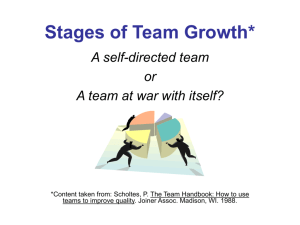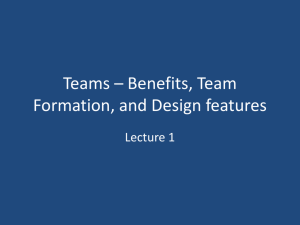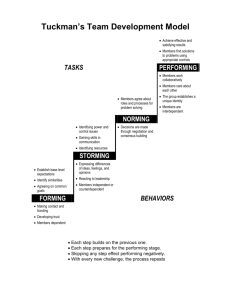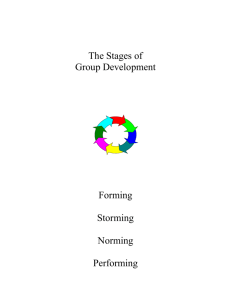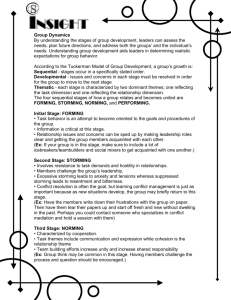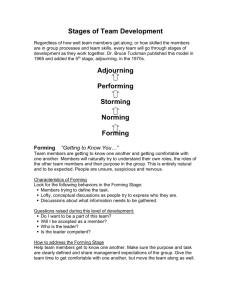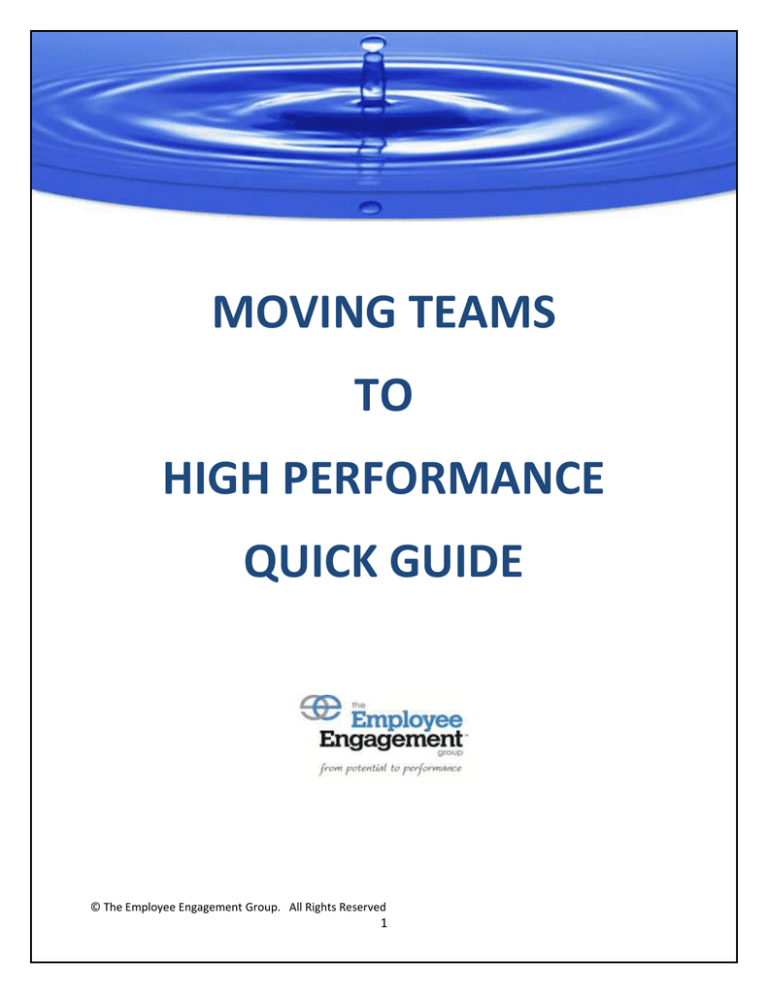
MOVING TEAMS
TO
HIGH PERFORMANCE
QUICK GUIDE
© The Employee Engagement Group. All Rights Reserved
1
Moving Teams to High Performance
Extensive research has shown that all teams go through discernable stages of development. The most
commonly used framework for team development was created by Bruce Tuckman. His descriptions of
the stages provide a useful framework for looking at teams, providing a common language and way to
understand the causes for changes in team behaviors. It can also be a relevant model for looking at the
phases that companies go through when changing and developing toward becoming a high performing
organization.
In our dynamic and growing business today, the one thing we can count on is that change is a constant.
One of the greatest challenges a leader has is helping his/her team members stay engaged and
effectively perform amidst many changes, such as new organizational structure, changing leadership
and/or membership, shifting goals and priorities, etc.
What you’ll find in this guide:
An overview of the 4 stages of team development – what you’ll see and can anticipate
Priority leadership tasks to effectively move teams through the stages
Helping teams through endings What leaders of new teams can do to give them the best
possible start (find more detailed information in Team Kickoff Process Guide)
What leaders of new teams can do to give them the best possible start (find more detailed
information in Team Kickoff Process Guide)
The Stages of Team Development
In this model, there are four stages—each with its own recognizable and predictable feelings and
behaviors. While the different stages are not so definite as to be thought of as steps, they are distinct,
and all teams go through them. The stages are most useful as a basis for team conversation, rather than
boxing a team into a “diagnosis.”
This process is not static. Any time there is an ending or a significant change in membership, structure,
or operational functioning, the team will return to the Forming stage. For example, losing or gaining a
member, merging teams, changing leaders, or an imposed change of assignment or goals.
Also, if it seems like your team might be skipping a stage, take a closer look to be sure you haven’t
missed something – teams almost never bypass any of the stages.
References
Bruce Tuckman. Developmental
Sequence in Small Groups. Psychological Bulletin, 63, pp. 384-399.
© The Employee Engagement Group. All Rights Reserved
2
The Stage of Team Development
Forming
•Excited to be part of the team; eager for
work ahead
•Some anxiety and uncertainty – What’s
expected of me? How will I fit in? How
will my performance measure up to
others?
•Politeness prevails; people may be
reticent to ask questions and share ideas
•Commitment and motivation are high,
and productivity is moderate, since
people are still learning the goals, roles,
and what’s expected
Performing
*
*
*
*
*
Focused on team vs. individual results
Understanding and using team
members’ strengths and valuing
differences
Showing high confidence
Sense of true collaboration and shared
team leadership
Commitment, morale and productivity
are all high
Storming
•Discover team may not live up to early excitement
Norming
& expectations
•Feeling frustrated, confused, or angry with team’s
progress or process
•Negative reactions to leader and other members;
possible power struggles
•Conflicts and disagreements about goals, roles,
responsibilities are either openly expressed or
“behind the scenes”
•Commitment, morale, and productivity take a
downturn
•Starting to resolve discrepancies between
individual expectations and reality of team
experience.
•Turbulence subsides and sense of calm prevails
•Increased understanding of accountabilities and
expectations
•Developing self-esteem, trust, and confidence in
team
© The Employee Engagement Group. All Rights Reserved
3
•Increasing sense of comfort in expressing “real”
ideas and feelings
•Commitment and productivity “on the upswing”
Primary Leadership Tasks for Each Stage
How quickly a team can move through each stage can vary widely between teams. If a leader effectively
handles the priority tasks in each stage, he/she will accelerate team development and performance.
Forming
Primary tasks are to provide direction and structure, and to build relationships and trust
o Define and clarify team and individual goals, roles, expectations, and practices
o Spend time together as a team, both doing work and learning more about each other both
professionally and personally
o Help people understand and manage transition and change
Share the concept of stages of team development to normalize the process and provide a common
framework
Teach and model skills and behaviors you want to see and recognize them when you do
Storming
Primary task is to legitimize and make conflict constructive
o Acknowledge with the team that storming is natural, inevitable, and essential to the growth of
the team
o Create forums and encourage open discussion of issues, even if directed at you as the leader, so
conflict is handled constructively vs. evaded or suppressed
o Reinforce positive conflict resolution efforts
o Balance individual needs with team needs
Revisit and re-clarify goals, roles, expectations (Note: Teams often can move more quickly through
storming if forming tasks were done well)
Norming
Primary task is to encourage norm development, participation, and continuous improvement
o Collectively review team norms, processes and practices and adjust based on what’s working
and isn’t
o Be less directive and more participative
o Encourage and give recognition for taking initiative, risks, creative problem-solving, and seeking
and acting on feedback
Continue to build trust and relationships through personal interactions and team building
Performing
Primary tasks are to enhance skills and to inspire more interdependence, shared ownership, and
accountability for results
Give people more responsibility; delegate some of your tasks to develop team member’s technical,
business, and leadership skills
© The Employee Engagement Group. All Rights Reserved
4
© The Employee Engagement Group. All Rights Reserved
o
o
o
Provide more feedback and additional “big picture” information, helping members make links to
the larger organization
Continue to celebrate individual and team successes
Look for new challenges; be on guard for “complacency and groupthink,” which may suggest
reinventing or making changes to the team
Team Endings: What You’ll See and What to Do
Teams will often come to an end, when their work is completed (such as a project team or task team) or
when the organization’s needs change (such as a reorganization or integration). In these situations, it’s
important for teams to pay attention to the ending process.
Members may have a variety of feelings around the team’s impending dissolution, and exhibit varied
behaviors as well:
Anxiety due to uncertainty about their new role or future responsibilities
Sadness or sense of loss about changes coming to their team relationships
Satisfaction about the accomplishments of the team
Conflicting feelings may occur at the same time, or rise and fall through the ending stage
Some may lose focus on team tasks and productivity may drop, while others find focusing on tasks
at hand is an effective response to their sadness or sense of loss.
What to do:
Acknowledge the upcoming transition and variety of ways that individuals and the team may be
feeling
Encourage people to express their feelings, concerns and really listen
Define what is over and what isn’t changing; treat the past with respect
Focus on four tasks:
o Acknowledge feelings and address concerns about “What’s going to happen to me?” in a
straightforward and caring way
o Complete any deliverables and achieve closure on remaining team work
o Capture “lessons learned” as a team; pass on to a new team leader or sponsor for future use
o Have some kind of closing activity or event that acknowledges and celebrates the contributions
of individuals and the team accomplishments.
New Beginnings:
How Leaders Can Get Teams Off to a Great Start
The leader who implements a strong and engaging kick-off process when a team is first forming helps
create “cohesiveness” – members are more committed to shared goals and priorities’, and feel part of
the team. Conversely, leaders who do not take proactive steps in the early months often find that their
teams struggle, fail to reach their performance potential, and get “stuck” in the storming stage.
© The Employee Engagement Group. All Rights Reserved
5
What to do:
Outline how the team has come together and reasons why. Express your excitement about the
future of the team and importance of building the team.
Be more directive and closely involved during this stage; take immediate steps to bring the team
together to openly discuss, create and clarify goals, roles, and team practices(e.g. how will the team
communicate, make decisions, give each other feedback, recognize accomplishments).
Incorporate “getting to know you” team building activities into team meetings, often and early, to
build relationships and trust.
Encourage members to share how they have functioned previously (good and bad) and their hopes
and expectations for the future. Outline your expectations for the team and individuals. In other
words, start to “contract” with the team.
Be open about the way you operate as a manager- your strengths and weaknesses – and ask for
ongoing feedback.
Check out the Team Kickoff Process Guide, which outlines a recommended approach for leaders to get
your new teams off to the best possible start. This guide provides a structured outline, agenda,
facilitator notes, and supporting materials for you to easily adapt and use in the early stages of your
team’s development.
© The Employee Engagement Group. All Rights Reserved
6

